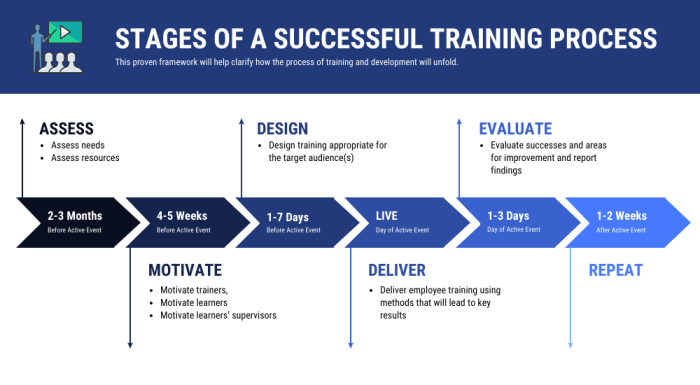Creating Employee Training Programs takes center stage, offering a glimpse into the world of employee development. Dive into the realm of well-designed programs that boost retention, satisfaction, and productivity.
Explore the steps involved in crafting effective training programs, aligning them with business objectives, and selecting the right methods for optimal learning outcomes.
Importance of Employee Training Programs

Employee training programs play a crucial role in the success of any organization. These programs not only benefit the employees but also contribute significantly to the overall growth and productivity of the company.
Benefits of Well-Designed Training Programs
- Improved Skills: Training programs help employees acquire new skills and knowledge, making them more efficient in their roles.
- Enhanced Productivity: With better skills and understanding of their tasks, employees can work more effectively, leading to increased productivity.
- Increased Job Satisfaction: When employees feel supported through training, they are more satisfied with their jobs and are likely to stay longer with the company.
Contribution to Employee Retention and Job Satisfaction
- Retention: Employees who receive training are more likely to stay with the company as they see opportunities for growth and development.
- Job Satisfaction: Training programs show employees that the organization values their professional development, leading to higher job satisfaction levels.
Enhancing Employee Skills and Productivity
- Skill Development: Training programs help employees improve their skills and stay updated with industry trends, making them more versatile and valuable assets.
- Productivity Boost: When employees are well-trained, they can perform their tasks more efficiently, leading to increased productivity and better outcomes for the company.
Designing Effective Training Programs
When it comes to creating top-notch training programs for employees, there are a few key steps to keep in mind. These steps will help ensure that the training is comprehensive, effective, and aligned with the business goals and objectives of the organization.
Identifying Training Needs
- Conduct a thorough assessment of the current skills and knowledge levels of employees.
- Identify any gaps between the desired skills and the skills currently possessed by employees.
- Consider the specific job roles and responsibilities within the organization to determine what training is needed.
Aligning Training Programs with Business Goals
- Clearly define the business goals and objectives that the training program should support.
- Ensure that the training content directly relates to the skills and knowledge needed to achieve those goals.
- Regularly review and update training programs to ensure they continue to align with the evolving needs of the business.
Types of Training Methods
When it comes to employee training, there are various methods that organizations can use to impart knowledge and skills to their workforce. Each method has its own strengths and weaknesses, so it’s important to consider the learning objectives and the nature of the content being taught when selecting the right training method.
On-the-Job Training, Creating Employee Training Programs
On-the-job training is a popular method where employees learn by doing tasks in their actual work environment. This hands-on approach allows employees to gain practical experience and apply their learning immediately. For example, a new sales associate shadowing an experienced employee to learn the ropes of customer service.
Workshops
Workshops are interactive training sessions that focus on a specific topic or skill. They often involve group activities, discussions, and practical exercises to engage participants. An example of a successful workshop training program is a leadership development workshop where managers learn key leadership skills through case studies and role-playing exercises.
E-Learning
E-learning, or online training, is a flexible and cost-effective method that allows employees to access training materials anytime, anywhere. This method is especially useful for remote or geographically dispersed teams. An example of a successful e-learning program is a cybersecurity training course that employees can complete at their own pace through an online platform.
Choosing the Right Training Method
When designing employee training programs, it’s crucial to select the right training method based on the learning objectives. For example, if the goal is to teach technical skills that require hands-on practice, on-the-job training might be the best choice. On the other hand, if the content is more theoretical or requires self-paced learning, e-learning could be more suitable. By aligning the training method with the desired learning outcomes, organizations can ensure that their employees receive the most effective training possible.
Implementing Training Programs: Creating Employee Training Programs

Implementing a training program involves a structured process from planning to evaluation. Engaging employees in the training process and ensuring their participation are crucial for the success of the program. Feedback and assessment play a key role in improving the effectiveness of training programs.
Planning the Training Program
- Identify training needs based on job requirements and employee skills.
- Set clear learning objectives and goals for the training program.
- Develop a detailed training plan with timelines and resources required.
Engaging Employees in Training
- Communicate the importance of training to employees and how it aligns with their career development.
- Involve employees in the training program design and allow them to provide input on topics of interest.
- Provide incentives or rewards for participation to motivate employees.
Feedback and Assessment
- Collect feedback from employees during and after the training program to identify areas for improvement.
- Use assessment tools such as quizzes, surveys, and evaluations to measure the effectiveness of the training.
- Adjust the training program based on feedback and assessment results to enhance its impact.
